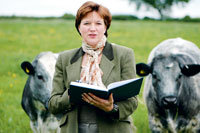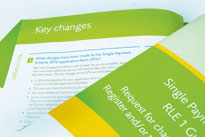Single Payment Scheme 2010: How to get it right

Single Payment Scheme claimants are being urged to take extra care when filling out SPS application forms in this, the sixth year of single farm payments.
While the forms may look familiar, several important changes have been introduced which could trip the unwary. The most significant stem from the Rural Land Register (RLR) mapping update, undertaken by the Rural Payments Agency for farmers in England.
In the past, application forms have been pre-printed with information from the previous year’s claim. But this year, information from the updated land register has been used.
It is, therefore, more important than ever to cross check what has been printed with the actual position of the land being claimed.
“We have tried to keep changes to a minimum,” says RLR policy manager Simon Lunniss. “But this year, following the mapping update, we’ve been able to include more information to help farmers complete their forms.”
In particular, this year’s application form includes a new column, C4, called “maximum area eligible for SPS”. The figures in this column equate to the “total field size”, given in column C3, minus the area of any permanent ineligible features, such as ponds or buildings.
Key dates4 April 17 May 1 June 11 June |
|---|
Such features have been marked on the new maps.
In the past, the claimant has had to make deductions for such ineligible features by hand on the form. Now they only have to check the figure in C4 against the index sheet sent out with the maps.
“Farmers should go back to their new maps and check that such features actually tally,” says Mr Lunniss. “They should certainly not enter the deductions again manually, or they will be losing out.”
As a result of including this new column, other columns from last year’s form have been shunted across to the right on the data sheet. For example, the “part field size” which was previously in C5 is now in C6. And the “area to activate entitlements” which was in C8 is now in C9.
“Where the data is blank against a particular field, it is essential the claimant writes the information in the relevant box,” says Mr Lunniss. “To highlight areas where we know data is missing, we have included an arrow in column C7, pointing to the incomplete area.
“If a farmer wishes to claim the SPS payment on such a land parcel, he should fill in all the columns with the correct information.
“But where data is pre-printed on the form and is correct, it is important that the claimant does not re-write the figure in the box below, as this will confuse the scanners and could delay any future payment,” he adds.
Under no circumstances should the figure in column C9, “area to activate entitlements”, exceed the figure in C4, “maximum area eligible for SPS”.
“Where you need to change the area we have printed in green in column C4 because of changes to permanent SPS ineligible features, you should send us a map or sketched map showing the changes, together with an RLE1 form,” says Mr Lunniss.
Farmers must also deduct from column C9 the area taken up by any SPS temporary ineligible features.
Other changes
One of the first things farmers may notice is that the front of the SPS application form is slightly different this year.
It includes more details about the farmer, with the address, telephone number and email address included. If these are wrong, phone the RPA on 0845 603 7777, or log on to SPS Online via the RPA Online section of the Whole Farm Approach website here.
Stemming from the mapping update, some National Grid field numbers may also be different, and total field areas may not be quite the same as in the past, as they have been re-surveyed using more accurate GPS mapping techniques.
Land use codes for 2010, (Column C8, printed in green), are pre-printed wherever possible, though some of these codes are different from previous years. For example, permanent crops should now all be entered as PC2, including short rotation coppice, which was previously EC1.
A guide to land use codes for 2010 is included in Annex A of the new SPS handbook for England.
If the code is not pre-printed, the farmer must input it manually. “If the code is not there, we cannot make a payment. It’s a legal requirement,” says Mr Lunniss.
Several changes have also emanated from the 2008 CAP “health check” instigated by former agriculture commissioner Mariann Fischer Boel.
This includes the fact that there is now a minimum claim size of 1ha, compared with 0.3ha in the past, and a minimum parcel size of 0.1ha.
 |
|---|
Furthermore, entitlements must now be used at least once every two years, rather than once every three years.
Another key change is that the Hill Farm Allowance scheme has been replaced by the new Uplands Entry Level Stewardship scheme, (UELS). But upland farmers who are still in a Countryside Stewardship Scheme or an ESA agreement may not join the UELS.
They may, however, claim an Uplands Transitional Payment, and this is done using the SPS application form, with full details spelled out in Section G of the explanatory handbook.
One final change this year is that the RPA has condensed the two sets of guidance notes into one, to try and simplify the application process.
Claiming your SFP online
For the first time this year claimants will be able to complete the SPS application online – last year this was only possible using dedicated software.
The RPA is sending out PIN letters to all farmers to help them register, and these letters will include guidance notes. The online application service will go live on 23 March.
SPS Online can be accessed through the Whole Farm Approach website and by clicking on the RPA Online link. But farmers should wait until they have received their paper form before accessing the electronic service.
SPS application forms will start to go out next week and will be sent to all known previous claimants. If you have not received a form by the first week of April, contact the RPA on 0845 603 7777. |
|---|
Alternatively, they can purchase the necessary software from Farmplan at www.farmplan.co.uk or Paul Holliday Software at www.phsoftwaresolutions.com
“Submitting your application online is free, as well as quicker and easier – and you know it’s got to the RPA as they instantly send you an online receipt which can be printed off and kept with your records,” says Billie Johnson of the Institute of Agricultural Secretaries and Administrators, (IAgSA).
“But I would not recommend this route if you have not used a computer before for general office management, unless you seek some training first. And, even if you are computer literate, do not leave it to the last minute to submit your on-line application as, by then, it will be too late to get help if things do go wrong.
“I would also advise farmers to keep their PIN letter safe, as this will enable them to track their claims at a later date.”
Whether the farmer is applying online or through the traditional paper route, Mrs Johnson says it is crucial that applicants reconcile the pre-printed data on their 2010 forms with their land, using their new maps and their 2009 application forms. “Farmers should have all three documents in front of them when making their applications,” she advises.
They are also urged to take a photocopy or printout of the SPS application form before sending it, for their records.
The RPA says it is anticipating a lot more interest in online applications from farmers this year, and is offering assistance via its Drop-in Centres, though farmers will need to make an appointment first.
Drop In-Centres
Drop-in centres have been surprisingly popular as a means of delivering the SPS application form, with around 30,000 farmers using them last year.
As such, the RPA is opening two more this year, at Truro in Cornwall and Wye in Kent, to provide better coverage.
Drop-in Centres are to be found in:
Bristol | Carlisle | Crewe | Exeter | Newcastle |
Newmarket | Northallerton | Nottingham | Reading | |
Truro | Worcester | Workington | Wye |
They will be open from 10 March between 8.30am and 5.00pm Monday to Friday, but closed on 2 and 5 April, and 3 and 31 May (Bank holidays). They will also be open on Saturday 15 and Sunday 16 May between 9.00am and 3.00pm.
Mapping update
The vast majority of maps have now been agreed with farmers – either at the first time of asking, or the second and these farmers will be sent their SPS application forms in the next few weeks, pre-printed with the updated land information.
Some farmers who requested changes to their maps too late will still be sent an SPS application form, but this will be pre-printed with the latest information held on the land register, but not including their requested changes.
Once these have been made, confirmatory maps will be sent out. It will be up to the farmer to check and, if necessary, amend the land information pre-printed on their field data sheet, to ensure it includes their requested changes and tallies with the position on their land.
Similarly, farmers who have been inspected and have not yet agreed the inspection findings, will receive an SPS application form pre-printed with the latest information held on the land register, but not incorporating any inspection findings.
Once these have been agreed and updated, confirmatory maps will be sent out. Again, the farmer will need to check this against their pre-printed form.
“We will not be sending out any blank forms this year,” said an RPA spokeswoman. “All farmers should be aware that, if the data on the SPS application form does not match the position on their land, it is their responsibility to ensure that it is updated by making appropriate changes to the application form.”
Dos and don’ts
Do | Don’t |
• Sign your form at Part I | • Use pencil, felt pen or correction fluid |
• Use black biro, not blue | • Use photocopies or computer-generated paper forms |
• Use original RPA forms only (unless submitting online) | • Remove staples or unused pages from the form |
• Complete the field data sheets in hectares, to two decimal places | • Cross through incorrect data on the field data sheet. |
• Attach sticky bar codes to any covering letters or attachments | • Fold the form and put it in a smaller envelope |
• Pay the right postage and get a receipt | • Forget to sign the form – still the most common error |
• Use valid 2010 crop codes | |
• Tell the RPA if you have an interest in any other UK farming business | |
• Consider using the new online service |
Payment rates
The 2010 single farm payment will be based on 25% of the entitlement holder’s historic subsidy receipts and a 75% flat rate element. The euro/sterling exchange rate will be taken at the end of September. There will be total modulation of 19%, though the first €5000 will be exempt from EU modulation.
For a comment on this year’s claims process, see Phil Clarke’s Business Blog and to find out how your can get your questions answered by officials from the RPA click here.
 |
|---|
